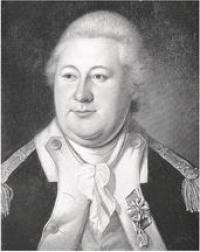From Fort Ticonderoga to Boston: The Wintry Trek of Henry Knox
By Cookie Steponaitis
|
While exploring the stories of the American Revolution most have heard of George Washington and the exploits of Vermont’s Green Mountain Boys and Ethan Allen; but few have heard the tale of Henry Knox and a trip involving sixty tons of artillery transported from Fort Ticonderoga to Boston in the winter of 1775, earning Henry Knox the well earned title of an unsung hero.
Henry Knox knew his artillery. In fact, he was one of the few men in the American military of 1775 that did. As the Chief of Artillery and a major general, Knox had a reputation for recovering and fixing artillery for the struggling Continental Army, under the command of General Washington. Born in poverty in Boston in 1775, Knox is by all definitions a self made man. Leaving school at an early age to help support his family, Knox had a keen interest in military history and was largely self-taught. He opened a book shop and did not become important in the American Revolution story until he joined the militia and quickly stood out because of his knowledge in military affairs and his ability to succeed with tasks.
Noticed and encouraged by General Washington, Knox was given the intriguing mission of going to Fort Ticonderoga to retrieve the collection of artillery that had been captured by Ethan Allen and his Green Mountain Boys on May 15, 1775. The cannons and artillery were to be moved to Washington’s location near Boston. Knox, in a letter to Washington accepted his task and promised to move this “…noble train of artillery…” hundreds of miles. The wilderness was covered in forests, mountains and was barely accessible to oxen, horses and men. Washington could not attack the British in Boston without the artillery and the Fort Ticonderoga collection would provide the force needed to turn the tide of battle. “The want of them is so great,” Washington wrote to his new officer Knox, “that no trouble or expense must be spared to obtain them.”
Twenty-five years of age and being a man of considerable size and muscle, Knox was known to be “energetic” and was up for the task. Arriving at the fort in Ticonderoga after a long horse trip, Knox found sixty of the guns still operational. There was a collection of four pound cannon, twenty-four pound cannon and mortars. The artillery pieces that required moving ranged from one to eleven feet in length and weighed a collective amount of 119,000 pounds. In letters to Washington and in his diary, Knox approached the trip with enthusiasm but also with a cautious realism of what was ahead of him.
Encountering his first major obstacle in a twelve mile overland move from Lake Champlain to Lake George, Knox and his men traversed the distance and loaded the precious cargo on a flat bottom scow and moved it in bitter cold weather toward Lake George. Traveling over thirty miles in one exhausting day, Knox was in an advance boat scouting the lake and native tribes ahead. Waiting for the scow to arrive Knox received the dreaded word that the scow and all of the cargo had sunk.
At this point, even the most devout of patriots would have turned around and returned to the warmth of Fort Ticonderoga. Knox not only traveled back to the site of the disaster, but seeing that part of the scow’s gunnel was out of the water ordered the men to bail until the scow was above the water line. After days of work the cargo was ashore, dried out and once again ready to travel overland down valleys and paths only wide enough for one man on foot. Knox reported in a letter to Washington, “I have 42 exceeding strong sleds and have 80 yoke of oxen to drag them to Springfield. There I shall get fresh cattle to carry them.” Predicting for the general his arrival would come in just over two weeks, Knox in fact took a full forty days to accomplish his miracle.
Tracing his path on a map today amazes the casual geographer of the sheer scope of what this trip entailed. Exhausted horses and oxen were lashed to each other with long ropes tied to each sled and team and moved eight to ten miles on a good day, traversing snow and two rivers. Remarking in his journal about wondrous sites of nature and calling the mountains, “Kingdoms of Earth,” Knox pays tribute to the men, animals and the importance of an environment that was common to freezing New England winters. Animals balked and had to be convinced and cajoled into pulling huge cargos uphill, downhill and across frozen water. Occasionally boosted by warm whiskey and cider, Knox and his men spent many a night tending the animals in sub zero weather and staying up all night to keep fires burning. Finally emerging in Massachusetts and continuing toward Washington on a path now called the General Knox Highway, Knox’s diligence earned him the praise and life long friendship of Washington and posts that included the first Secretary of War and a hand in developing of the area of Maine. A veteran soldier and statesman, Henry Knox died in 1850 receding into history, largely forgotten.
The next time you travel the roads near Fort Ticonderoga and gaze at the tonnage of the artillery lining the walls of the fort, imagine moving that one icy winter by hand and beast in the name of freedom and you will have a sense of the passion and skill of one of history’s many unsung heroes, Henry Knox.

